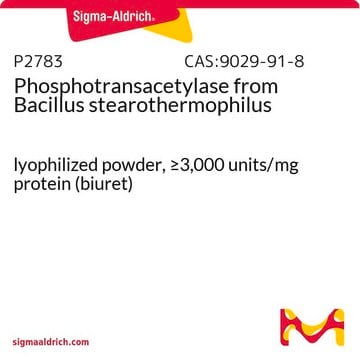MABS1352
Anti-N3-Phosphohistidine (3-pHis) Antibody, clone SC56-2
clone SC56-2, from rabbit
Sinónimos:
N3-Phosphohistidine
About This Item
Productos recomendados
origen biológico
rabbit
Nivel de calidad
forma del anticuerpo
purified antibody
tipo de anticuerpo
primary antibodies
clon
SC56-2, monoclonal
reactividad de especies
human, E. coli
reactividad de especies (predicha por homología)
all
técnicas
dot blot: suitable
western blot: suitable
isotipo
IgG
Condiciones de envío
wet ice
modificación del objetivo postraduccional
phosphorylation (N3-pHis)
Descripción general
Especificidad
Aplicación
Western Blotting Analysis: Clone SC56-2 hybridoma culture supernatant was employed for Western blotting analysis of heat-sensitive histidine N3-phosphorylation (3-pHis) of exogenously expressed human PGAM GST fusion protein in lysates from transformed E. coli (Fuhs, S.R., et al. (2015). Cell. 162(1):198-210).
Note: DO NOT HEAT SAMPLES prior to phosphohistidine detection. Histidine phosphorylation is heat and acid labile. To generate negative control for specificity test, an aliquot of sample can be heated at 95ºC for 10-15 minutes to reverse histidine phosphorylation. Alternatively, an aliquot of sample can be incubated under acidified pH at 37ºC for 15 minutes to reduce histidine phosphorylation. Acidify each 100 µL sample with 25 µL of 1 M HCl before the incubation, then neutralize with 25 µL of 1 M NaOH prior to phosphohistidine detection.
Calidad
Western Blotting Analysis: 0.52 µg/mL of this antibody detected recombinant human phosphoglycerate mutase (PGAM) with N3-phosphohistidine (3-pHis) in a 5 µg aliquot of PGAM-catalyzed 2,3-diphosphoglycerate (2,3-DPG) degradation reaction.
Descripción de destino
Forma física
Otras notas
Not finding the right product?
Try our Herramienta de selección de productos.
Opcional
Código de clase de almacenamiento
12 - Non Combustible Liquids
Clase de riesgo para el agua (WGK)
WGK 1
Punto de inflamabilidad (°F)
Not applicable
Punto de inflamabilidad (°C)
Not applicable
Certificados de análisis (COA)
Busque Certificados de análisis (COA) introduciendo el número de lote del producto. Los números de lote se encuentran en la etiqueta del producto después de las palabras «Lot» o «Batch»
¿Ya tiene este producto?
Encuentre la documentación para los productos que ha comprado recientemente en la Biblioteca de documentos.
Nuestro equipo de científicos tiene experiencia en todas las áreas de investigación: Ciencias de la vida, Ciencia de los materiales, Síntesis química, Cromatografía, Analítica y muchas otras.
Póngase en contacto con el Servicio técnico







